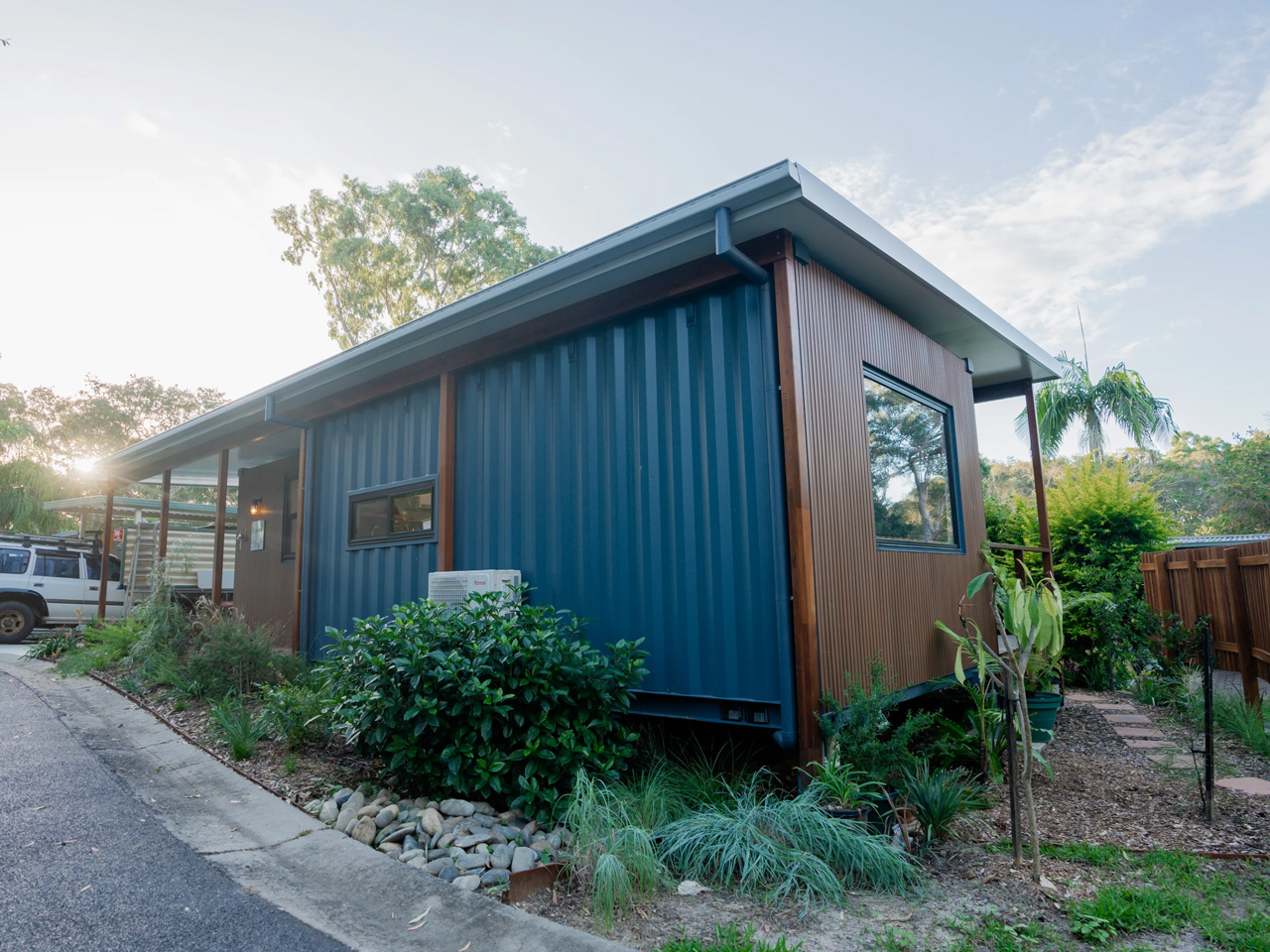The Seaholme by Modulate showcases an important and exciting leap forward in shipping container architecture. Located in the coastal town of Sawtell, NSW, this project transforms two modified containers into a cohesive living space that feels spacious and refined. The collaboration with Baldwin Building Group makes an interesting example of how industrial materials can be elevated through careful planning and execution. Rather than simply converting existing containers, Modulate created custom extra-wide units measuring 6m x 3.5m each, gaining precious additional width that fundamentally changes the interior experience.
The L-shaped configuration creates natural zones within the compact footprint while maintaining visual flow throughout the space. One container houses the living area and kitchen, while the second contains the bedroom and bathroom, with both units connected by a sheltering roof structure. This arrangement maximizes both interior space and outdoor living potential, creating distinct areas for different activities without sacrificing the sense of openness. The strategic placement allows for cross-ventilation and natural light penetration from multiple angles.
Designer: Modulate
What is Shipping Container Architecture?
Shipping container architecture is a design approach that repurposes steel shipping containers, originally used for freight transport, into building blocks for homes, offices, and commercial spaces. These containers are modular, durable, and easily transported, making them an excellent choice for innovative and sustainable construction. Architects and designers modify containers by cutting, reinforcing, and insulating them, then arranging them in various configurations to create functional, modern spaces.
This technique is an ideal option for architects and homeowners seeking efficiency and environmental responsibility. Since industrial materials are repurposed, shipping container architecture reduces construction waste and supports circular design principles. The method allows for flexible layouts, quick assembly, and the integration of eco-friendly systems. As a result, container-based buildings are gaining popularity for their adaptability, cost-effectiveness, and unique aesthetic.
The exterior cladding is crafted from a composite material containing 60% recycled timber and 40% recycled plastic. This low-maintenance finish provides durability while reducing environmental impact, aligning with contemporary expectations for responsible building practices. The composite material weathers naturally and requires minimal upkeep, making it ideal for the coastal environment. The material selection reflects an inclusion of circular design principles, where waste products become valuable building components.
The interior layout focuses on efficiency and multi-functionality, with every square meter serving multiple purposes. The kitchen features a breakfast bar that doubles as a workspace, while built-in storage solutions maximize vertical space throughout. The bedroom incorporates a dedicated home office area, acknowledging the reality of remote work requirements. The bathroom adopts a wet room configuration with accessibility features, proving that compact spaces can accommodate diverse user needs. Custom joinery and clever storage solutions ensure that daily living functions operate smoothly within the constrained footprint.
The covered porch area extends the living space outdoors, creating a seamless transition between the interior and exterior environments. Large sliding glass doors open the living area completely to the porch, effectively doubling the perceived space during pleasant weather. The kitchen includes a serving window that opens directly onto the porch, facilitating outdoor entertaining and dining. This outdoor room becomes an essential component of the overall design, not merely an afterthought.
The Seaholme proves that modular construction can achieve architectural sophistication while maintaining cost efficiency and construction speed. The project breaks down preconceptions about container living, displaying how custom modifications and careful planning can create homes that feel generous rather than cramped. The attention to proportion, material quality, and functional planning elevates this tiny home beyond mere novelty into a genuine architectural achievement.
What are the Pros of living in a Shipping Container Home?
Shipping container homes are often less expensive to build than traditional houses.
Repurposing containers reduces waste and supports eco-friendly building practices.
What are the Cons of living in a Shipping Container Home?
Containers require significant insulation and moisture control to be comfortable in different climates, which can add to costs.
Navigating local building codes and obtaining permits can be challenging, as not all regions are familiar with container homes.
Our Conclusion
Living in a shipping container home brings real advantages, from cost savings to a lighter environmental footprint, but it also introduces unique design and regulatory challenges that demand thoughtful solutions. The Seaholme tiny home is a satisfying and compelling answer to these hurdles, offering a layout that maximizes every square meter while maintaining a sense of openness and comfort rarely found in compact dwellings.
It features a unique L-shaped form that adds a new face to modular living. The interiors are beautifully crafted, balancing functionality with a refined aesthetic, and every essential amenity is included. Taking this home into consideration, it is safe to say that with careful planning and creative design, shipping container architecture can successfully deliver practicality as well as a truly comfortable and luxurious living experience.
The post This L-Shaped Shipping Container Home Proves Small Space Living Can Be Luxurious first appeared on Yanko Design.

